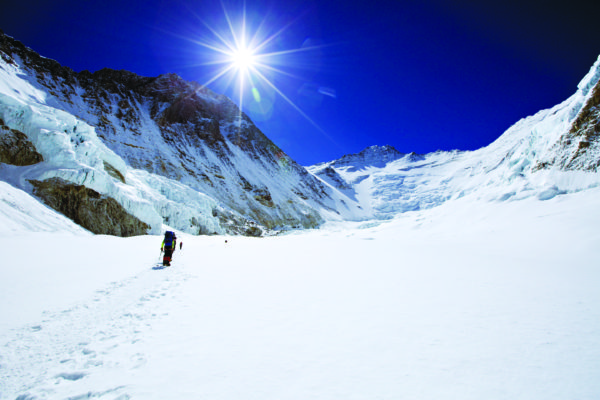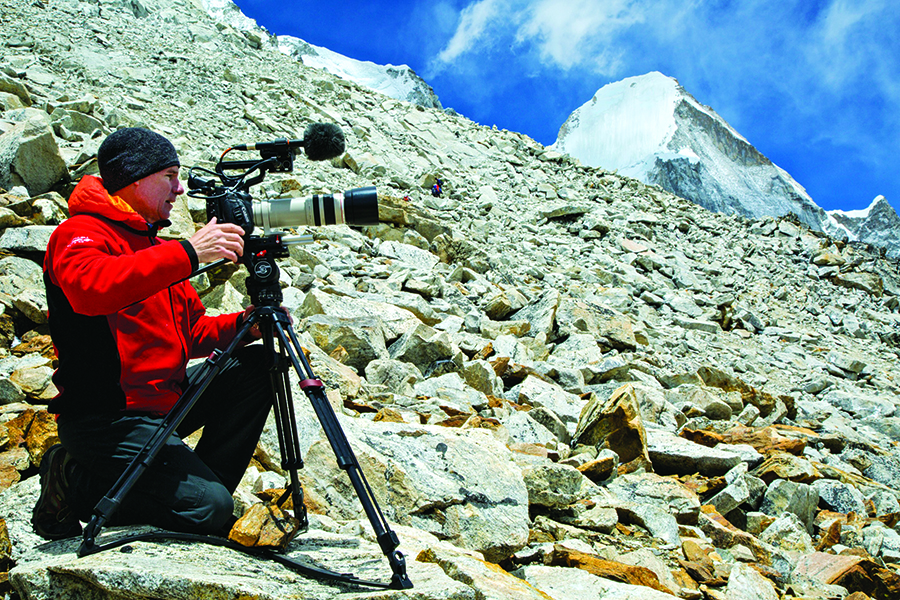Roughly two-and-a-half months ago, cinematographer David Rasmussen got a call. There was a job he’d be great for, one needing a professional of his wide range of skills.
The suggested focus of this National Geographic documentary would be an army climbing team from the United Arab Emirates. But the real star would inevitably be the setting: Mount Everest, the tallest mountain in the world and a magnet for those seeking to prove their mettle.
And for Rasmussen, his fourth meeting with the mountain would be sooner than he expected.
“On March 21, I got a call to see if I would film another Everest expedition,” Rasmussen said while sitting in a gliding rocking chair in his Whitefish-area home. “That was a Monday. The next Monday, I was in Kathmandu.”

With a mere week’s notice, Rasmussen packed up 250 pounds of gear and flew halfway around the world for a shoot that could last three months. It’s a fast-paced, adrenaline-filled lifestyle, but aside from his creative skills and excellent compositional eye, Rasmussen’s calm and even-keeled demeanor are likely what keeps companies hiring the 58-year-old cinematographer for projects all over the world.
The recent sojourn with the UAE army members began in March and didn’t wrap up until the group managed to summit Everest in late May; the trip takes months due to the time needed to actually get to the mountain and acclimate to the thin and deadly atmosphere.
Rasmussen has filmed on Everest four times and summited twice. In those two summit expeditions, he lost access to his oxygen above 26,000 feet, the elevation that is considered the death zone because it cannot support life. The summit is at 29,029 feet.
Watching climbers tackle that last section without oxygen is excruciating – video footage from such climbs shows the lack of oxygen taking its toll, with each step requiring minutes of deliberation and willpower to muster.
“He’s always liked to travel,” Margie Rasmussen, David’s wife, said, making a salad in their kitchen. “It just always seemed like his body was made to do what he’s doing. I don’t worry too much.”
The Rasmussens’ house is decorated with photos and mementos of the family’s adventurous times. The couple’s three sons were raised and homeschooled here, with an emphasis on the outdoors.
As a kid, Rasmussen said he was always climbing. He grew up in the Black Hills of South Dakota, caving and exploring the region. Eventually he’d move on to climbing larger mountains, like Mount Rainier.
He knew he wanted to be a cameraman, Rasmussen said, and completed his schooling at Montana State University in Bozeman. He was hired on to do documentary work with Boeing, and traveled all over the globe with the company.
Eventually, he moved back to Northwest Montana, where he’d spent summers in college working for the National Park Service in Glacier National Park.
In 1999, National Geographic commissioned Rasmussen to produce a six-part series in Pakistan on K2, the second-tallest mountain in the world and a mountain that kills one of every four climbers attempting to summit. He felt a particular connection to this project, Rasmussen said, because it was his idea.
Four years later, Rasmussen worked as a documentary filmmaker and high-altitude cameraman during the 2003 Everest Speed Expedition, which put the first Italian woman on the Everest summit. In 2006, he went back to Everest with the British Army Expedition as it tackled the treacherous and deadly West Ridge route.
In 2007, he summited Everest while filming the Everest Xtreme Expedition as a cameraman for BBC Horizon. That trip was especially rewarding, Rasmussen said, because he filmed a team of doctors and climbers who were studying the relationship between genetics and altitude.
“It was the best expedition I’ve ever been on because it was meaningful,” he said.
Rasmussen is also a proponent of adventuring with his family, with frequent camping, canoeing, caving, rock and ice climbing and mountaineering trips. In 1989, he and Margie backpacked the 3,100-mile Continental Divide Trail – “We had to use maps and compasses back then,” he said – and in 2013, he and his eldest son were hired to film an expedition on Mt. Ararat in eastern Turkey.
These opportunities seemed to spring up before him, Rasmussen said, and after this most-recent trip to Everest, he felt a little reticent about going back. But, like anyone who has become accustomed to adventure, he had a caveat.
“I’m not convinced I’ll go back to Everest,” he said, adding, “it would have to be a really good expedition.”
